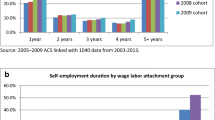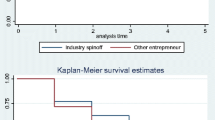Abstract
This paper analyzes self-employment entry among Swedish-born male wage-earners. Is it the best and the brightest or the least successful that become self-employed? The residual from an income regression is used as an indicator of who belongs to which group. We find that both wage-earners who receive a lower income than predicted, i.e. have a negative residual, and those who receive a higher income than predicted, i.e. have a positive residual, are more likely to become self-employed than those who receive an income close to the predicted one. However, splitting self-employment into different types depending on corporate form and number of employees, we find that the self-employed are drawn from both tails of the residual distribution only if it is a matter of unincorporated firms. Wage-earners who become self-employed and start an incorporated firm are only drawn from the top of the residual distribution. Using self-employment income and turnover as measures of self-employment performance, we find a positive linear relationship between the income residual and performance.



Similar content being viewed by others
Notes
See Gielen and Van Ours (2007) for an overview of this research.
See Carree and Thurik (2003) for an extensive survey of the impact of entrepreneurship on growth.
The results from the income regression are not presented here but are available from the authors upon request.
For a description of the definitional problems of this group, see Sect. 3.2.
The regressions have been estimated without controls and with a smaller set of controls. Although the size of the estimates changes slightly the main results are not affected.
2001 is chosen as the starting year since this is the first year for which we have information on occupation.
In 2006, the lowest income in a collective agreement for workers organized by LO (the blue-collar union) was 13,600 SEK (LO-tidningen 2006).
The results for estimations with the ten decile groups are available from the authors upon request.
This is the variable provided by Statistics Sweden; no other measure of the incomes for the self-employed is available.
References
Acs, Z., Audretsch, D., Braunerhjelm, P., & Carlsson, B. (2005). Growth & entrepreneurship: An empirical assessment. CEPR discussion paper no. 5409. Social Science Research Network.
Altonji, J. G., & Shakotko, R. A. (1987). Do wages rise with job seniority? Review of Economic Studies, 54(3), 437–459.
Amit, R., Glosten, L., & Muller, E. (1993). Challenges of theory development in entrepreneurship research. Journal of Management Studies, 30(5), 815–834.
Andersson Joona, P., & Wadensjö, E. (2007). Do the unemployed become successful entrepreneurs? A comparison between the unemployed, inactive and wage-earners. International Journal of Manpower, 28(7), 604–626.
Asoni, A. (2010). What drives entrepreneurship? Mimeo. University of Chicago.
Åstebro, T., Chen, J., & Thompson, P. (2010). Stars and misfits: Self-employment and labor market frictions. Working paper no. 1003. Florida International University, Department of Economics.
Barth, E., & Dale-Olsen, H. (1999). The employer’s wage policy and workers turnover. In J. Haltiwanger, J. Lane, J. Spletzer, J. Theeuwes, & K. Troske (Eds.), The creation and analysis of employer-employee matched data (pp. 285–312). Amsterdam: North-Holland.
Bishop, J. H. (1990). Job performance, turnover, and wage growth. Journal of Labor Economics, 8(3), 363–386.
Bjuggren, C. M., Johansson, D., & Stenkula, M. (2010). Using self-employment as a proxy for entrepreneurship: Some empirical caveats. IFN working paper, no. 845.
Blanchflower, D. G. (2000). Self-employment in OECD countries. Labour Economics, 7(5), 471–505.
Blanchflower, D. G. (2004). Self-employment: More may not be better. Swedish Economic Policy Review, 11(2), 15–73.
Blanchflower, D. G., & Meyer, B. D. (1994). A longitudinal analysis of the young self-employed in Australia & the United States. Small Business Economics, 6(1), 1–19.
Borjas, G. T., & Bronars, S. G. (1989). Consumer discrimination and self-employment. Journal of Political Economy, 97(3), 581–605.
Borland, J., & Lye, J. (1996). Matching and mobility in the market for Australian rules football coaches. Industrial and Labor Relations Review, 50(1), 143–158.
Bosma, N., & Harding, R. (2007). Global entrepreneurship. GEM 2006 summary results. Babson, MA and London: Babson College & London Business School.
Burke, A., FitzRoy, F., & Nolan, M. A. (2008). What makes a die hard entrepreneur? Beyond the ‘employee or entrepreneur’ dichotomy. Small Business Economics, 31(2), 93–115.
Carree, M. A., & Thurik, A. R. (2003). The impact of entrepreneurship on economic growth. Chap. 17. In Z. Acs & D. B. Audretsch (Eds.), Handbook of entrepreneurship research (pp. 437–472). Dordrecht: Kluwer.
Davidsson, P., & Henrekson, M. (2002). Determinants of the prevalence of start-ups and high-growth firms. Small Business Economics, 19(2), 81–104.
Fölster, S. (2000). Do entrepreneurs create jobs? Small Business Economics, 14(2), 137–148.
Folta, T. B., Delmar, F., & Wennberg, K. (2010). Hybrid entrepreneurship. Management Science, 56(2), 253–269.
Företagarförbundet. (2010). Här skapas jobben – småföretagen som nyanställer, Report from Företagarförbundet. www.ff.se, 29 October 2010.
Freeman, R. (1980). The exit-voice tradeoff in the labor market: Unionism, job tenure, quits & separations. Quarterly Journal of Economics, 94(4), 643–673.
Gielen. A. C., & Van Ours, J. C. (2007). Why do worker-firm matches dissolve? Mimeo. Tilburg University
Henrekson, M. (2005). Entrepreneurship: A weak link in the welfare state? Industrial and Corporate Change, 14(3), 437–467.
Henrekson, M., & Stenkula, M. (2010). Entrepreneurship and public policy. In Z. J. Acs & D. B. Auydretsch (Eds.), Handbook of entrepreneurship research: An interdisciplinary survey and introduction (pp. 595–637). New York: Springer.
Lazear, E. P. (1986). Raids and offer matching. In R. Ehrenberg (Ed.), Research in labor economics (Vol. 8, pp. 141–165). Greenwich: JAI Press.
Lazear, E. P. (2005). Entrepreneurship. Journal of Labor Economics, 23(4), 649–680.
LO-tidningen. (2006) Tjänstemannafack har sämsta lägstalönerna. http://lotidningen.se/2006/10/27/tjnstemannafack-har-smsta-lgstalnerna/, 13 August 2010.
NUTEK. (2005). Vem vill bli företagare? Attityder till företagande i Sverige 2004, Serie B 2005: 2. Stockholm: NUTEK Förlag.
Ohyama, A. (2008). Entrepreneurship and advanced technical knowledge. Research paper. Champaign: Institute for Genomic Biology (Business, Economics & Law), University of Illinois at Urbana-Champaign.
Parker, S. C. (2009). The economics entrepreneurship. Cambridge: Cambridge University Press.
Poschke, M. (2009). Who becomes an entrepreneur? Labor market prospects & occupational choice. Mimeo. McGill University.
Sanandaji, T. (2010). Self-employment does not measure entrepreneurship. Mimeo. University of Chicago, Harris School of Public Policy.
von Greiff, J. (2009). Displacement and self-employment entry. Labour Economics, 16(5), 556–565.
Wagner, J. (2004). Are young and small firms hothouses for nascent entrepreneurs? IZA discussion paper, no. 989.
Wagner, J. (2007). What a difference a Y makes: Female and male nascent entrepreneurship in Germany. Small Business Economics, 28(1), 1–21.
Acknowledgments
We want to thank two anonymous referees, seminar participants and Åsa Rosén for comments on earlier versions of this paper.
Author information
Authors and Affiliations
Corresponding author
Appendix
Appendix
See Tables 9, 10, 11, 12, 13, 14, and 15.
Rights and permissions
About this article
Cite this article
Andersson Joona, P., Wadensjö, E. The best and the brightest or the least successful? Self-employment entry among male wage-earners in Sweden. Small Bus Econ 40, 155–172 (2013). https://doi.org/10.1007/s11187-011-9365-0
Accepted:
Published:
Issue Date:
DOI: https://doi.org/10.1007/s11187-011-9365-0
Keywords
- Self-employment entry
- Entrepreneurship
- Occupational choice
- Occupational mobility
- Self-employment performance




